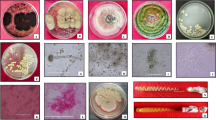Abstract
Strains in the culture collection of the Centraalbureau voor Schimmelcultures under the generic namesEndomyces andEndomycopsis were compared with related genera of filamentous and yeast-like fungi. The genusEndomyces is accepted for ascigerous states ofGeotrichum; 6 species are keyed out and discussed. The genus nameEndomycopsis is rejected as it is an obligate synonym ofSaccharomycopsis. ForEndomyces javanensis, Endomycopsis platypodis andSaccharomycopsis synnaedendra the new generaArthroascus, Hormoascus andBotryoascus are proposed; the genusGuilliermondella is reintroduced. Briefly discussed are the generaSchizosaccharomyces, Eremascus, Dipodascus, Ascoidea, Cephaloascus, Ambrosiozyma andCrebrothecium. A key is given for the genera of yeast-like “ascomycetes” with septate hyphae. Some species described asGeotrichum are transferred to other genera.
Similar content being viewed by others
References
von Arx, J. A. 1970. The genera of fungi sporulating in pure culture. - J. Cramer, 3301 Lehre, B.R.D.
Batra, L. R. 1959. A comparative morphological and physiological study of the species ofDipodascus. - Mycologia51: 329–355.
Batra, L. R. 1963. Contributions to our knowledge of ambrosia fungi. II.Endomycopsis fasciculata nom.nov. (Ascomycetes).- Amer. J. Bot.50: 481–487.
Batra, L. R. 1971. Two new Hemiascomycetes:Pichia crossotarsi andP. microspora. - Mycologia63: 994–1001.
Batra, L. R. andFrancke-Grosmann, H. 1964. Two new ambrosia fungi —Ascoidea asiatica andA. africana. - Mycologia56: 632–636.
Boidin, J., Abadie, F., Jacob, J. L. etPignal, M. C. 1962. Les levures à spores réniformes. - Bull. Soc. Mycol. Fr.78: 155–203.
Brefeld, O. 1891. Die Formen der Ascomyceten und ihre Cultur in NÄhrlösungen. p. 119–156.In Unters. aus dem Gesamtgebiete der Mykologie 9. Heft. - H. Schöningh, Münster i.W.
Butler, E. E. andPetersen, L. J. 1972.Endomyces geotrichum a perfect state ofGeotrichum candidum.- Mycologia64: 365–374.
Caretta, G. 1962.Trichosporon pullulans e la sua forma ascoforaMagnusiomyces ludwigii. - Atti Ist. Bot. Univ. Lab. Crittogam. Pavia 5,19: 22–38.
Carmichael, J. W. 1957.Geotrichum candidum. - Mycologia49: 820–830.
Gams, W. undDomsch, K. H. 1969. Bemerkungen zu einigen schwer bestimmbaren Bodenpilzen. - Nova Hedwigia18: 1–29.
Gams, W. undGrinbergs, J. 1970.Ascoidea corymbosa n.spec., ein hefeÄhnlicher Pilz im Bast vonAraucaria araucana. - Acta Bot. Neerl.19: 794–798.
Guilliermond, A. 1909. Recherches cytologiques et taxonomiques sur les Endomycétacées. - Rev. Gén. Bot.21: 353–401.
Kreger-van Rij, N. J. W. andVeenhuis, M. 1969. Septal pores inEndomycopsis platypodis andEndomycopsis monospora. - J. Gen. Microbiol.57: 91–96.
Kreger-van Rij, N. J. W. andvan der Walt, J. P. 1963. Ascospores ofEndomycopsis selenospora (Nadson et Krassilnikov) Dekker. - Nature199: 1012–1013.
Lodder, J. [ed.] 1970. The yeasts, a taxonomic study. - North Holland Publ. Co., Amsterdam.
Marasas, W. F. O. 1971. Cotton staining caused byCrebrothecium ashbyi (=Eremothecium ashbyi) in South Africa.- Bothalia10: 407–410.
Morenz, J. 1963.Geotrichum candidum. - Mykol. Schriftenreihe1. Leipzig, 79 pp.
Morenz, J. 1964. Taxonomische Untersuchungen zur GattungGeotrichum. - Mykol. Schriftenreihe2: 33–64.
Routien, J. B. 1949.Crebrothecium ashbyi. - Mycologia41: 183–185.
Schiönning, H. 1903. Nouveau genre de la famille des Saccharomycètes. - C.R. Trav. Lab. Carlsberg6: 103–125.
Scott, D. B. andvan der Walt, J. P. 1971.Pichia cicatricosa sp.n., a new auxiliary ambrosia fungus.- Antonie van Leeuwenhoek37: 177–183.
Stautz, W. 1931. BeitrÄge zur Schleimflussfrage. - Phytopathol. Z.3: 163–229.
Stelling-Dekker, N. M. 1931. Die sporogenen Hefen. - Verh. Kon. Akad. Wetenschap. Amsterdam28: 1, 547 pp.
Stolk, A. C. andDakin, J. C. 1966.Moniliella, a new genus of the Moniliales. - Antonie van Leeuwenhoek32: 399–409.
Streiblová, E. 1963. On the question of the taxonomy ofEndomycopsis javanensis (Kloecker) Dekker. - Folia Microbiol. (Prague)8: 170–175.
van der Walt, J. P. 1972. The yeast genusAmbrosiozyma gen. nov. (Ascomycetes). - Mycopathol. Mycol. Appl.46: 305–315.
van der Walt, J. P. andScott, D. B. 1971. The yeast genusSaccharomycopsis Schiönning.- Mycopathol. Mycol. Appl.43: 279–288.
Windisch, S. 1951. Zur Biologie und Systematik des Milch-Schimmels und einiger Ähnlicher Formen. - Beitr. Biol. Pflanz.28: 69–130.
Zender, J. 1925. Sur la classification des Endomycétacées. - Bull. Soc. Bot. Genève17: 246–276.
Author information
Authors and Affiliations
Additional information
The author thanks Mrs. Dr. N. J. W. Kreger-van Rij, Dr. J. P. van der Walt, Dr. E. E. Butler, Dr. W. Gams and Mr. D. Yarrow for helpful suggestions, for reading the manuscript and for sending cultures.
Rights and permissions
About this article
Cite this article
von Arx, J.A. OnEndomyces, Endomycopsis and related yeast-like fungi. Antonie van Leeuwenhoek 38, 289–309 (1972). https://doi.org/10.1007/BF02328100
Received:
Issue Date:
DOI: https://doi.org/10.1007/BF02328100




